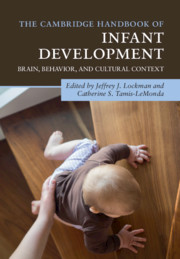Book contents
- The Cambridge Handbook of Infant Development
- The Cambridge Handbook of Infant Development
- Copyright page
- Dedication
- Contents
- Illustrations
- Contributors
- Preface
- Part I Foundations
- Part II Perceptual Development
- Part III Cognitive Development
- Part IV Action
- 17 Action in Development
- 18 The Mirror Neuron System and Social Cognition
- 19 Infant Object Manipulation and Play
- 20 The Infant’s Visual World
- Part V Language
- Part VI Emotional and Social Development
- Index
- References
19 - Infant Object Manipulation and Play
from Part IV - Action
Published online by Cambridge University Press: 26 September 2020
- The Cambridge Handbook of Infant Development
- The Cambridge Handbook of Infant Development
- Copyright page
- Dedication
- Contents
- Illustrations
- Contributors
- Preface
- Part I Foundations
- Part II Perceptual Development
- Part III Cognitive Development
- Part IV Action
- 17 Action in Development
- 18 The Mirror Neuron System and Social Cognition
- 19 Infant Object Manipulation and Play
- 20 The Infant’s Visual World
- Part V Language
- Part VI Emotional and Social Development
- Index
- References
Summary
Natural and manufactured objects saturate human culture. Infants need not do much or go far to find objects of different shapes, textures, sizes, and functions throughout their environments. And, as they manipulate and play with objects, they learn quite a lot along the way. From the time they can swipe and grab, infants spend most of their awake hours exploring objects – moving seamlessly from object to object in short bursts of activity distributed over time. These bouts of object interaction allow infants to practice and refine manual skills, learn about object features and functions, and test the fit between body and environment. Object interactions also allow infants to extend the limits of reality. Infants can pretend that objects exist when they do not, use objects to stand for other objects, and generate unique ways to use objects beyond their intended design. Indeed, to fully engage human artifact culture, infants must become proficient at using objects in twin planes of action – the real and the imagined.
Keywords
- Type
- Chapter
- Information
- The Cambridge Handbook of Infant DevelopmentBrain, Behavior, and Cultural Context, pp. 520 - 548Publisher: Cambridge University PressPrint publication year: 2020
References
- 3
- Cited by



